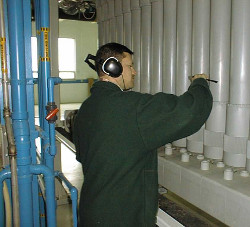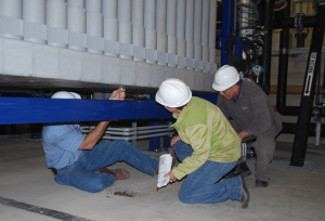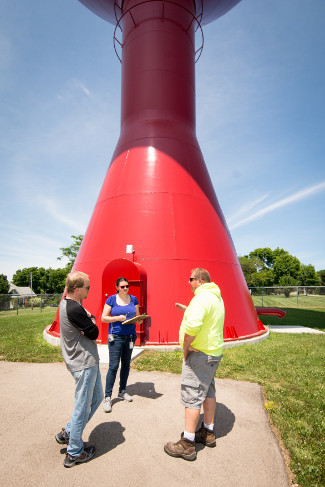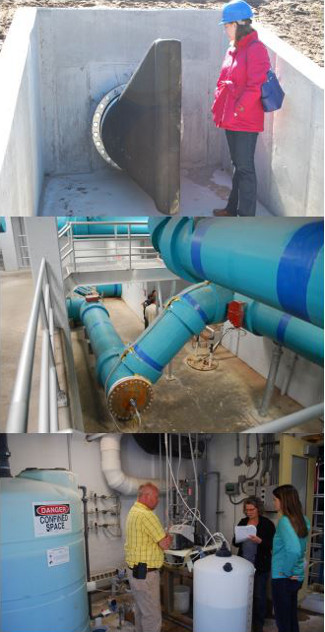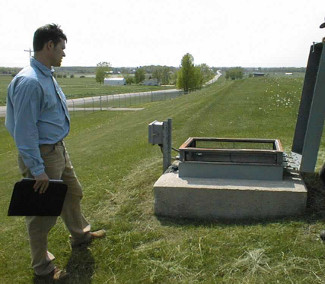Municipal drinking water system sanitary survey
A sanitary survey is an inspection of a water system's facilities, operations and records to ensure the delivery of safe and reliable drinking water. In Wisconsin, the DNR conducts routine sanitary surveys of municipal drinking water systems every three years. A print-friendly fact sheet also summarizes all information.
Purpose
Sanitary survey purpose
Proper operation and maintenance of your municipal drinking water system is essential for providing safe water to your community. State and federal regulations are in place to help public water system operators safely provide this vital service. The DNR's Drinking Water and Groundwater Program manages activities that affect the safety, quality and availability of drinking water to protect public health and water resources.
The sanitary survey is also an opportunity to discuss your water system with your DNR contact, ask questions, learn new strategies to optimize your system and identify potential problems before they lead to unsafe drinking water. DNR staff are a great resource for technical assistance, so don't hesitate to ask them questions or talk through options.
Process
Sanitary survey process
DNR staff will contact the municipal drinking water system operator-in-charge or other knowledgeable staff to schedule a convenient time for the survey. The department recommends reviewing the Sanitary Survey Checklist in advance, so you are familiar with all elements of the survey. Reviewing information and organizing records ahead of time will help ensure a successful survey.
DNR staff will evaluate the physical construction, operation and maintenance of the entire drinking water system during the sanitary survey. This will include a discussion to develop a plan and timetable for correcting any noted deficiencies. DNR staff will need to visit every component of the drinking water system, including out-of-the-way wells, pumping stations, reservoirs, booster stations, etc. Be prepared to access these locations and navigate snow, rain and cold temperatures. The day will also include a review of required records followed by a wrap-up meeting to discuss results.
- Source
- Treatment
- Distribution system
- Finished water storage
- Pumps, pumping facilities, controls
- Monitoring and reporting
- Water system management and operations
- Operator certification
Survey preparation
Municipal sanitary survey preparation
Sanitary surveys evaluate the adequacy of the water source and examine the facilities, equipment, operation, maintenance, monitoring, record keeping and any required public noticing. After the sanitary survey, you will receive a report outlining corrective actions if needed.
The operator-in-charge is requested to be present as the person most knowledgeable about the operation of the physical drinking water system. Any other water system officials are encouraged to attend, including a sanitary district or village president, mayor, director of public works, clerk, other operators or board/commission members.
To ensure your survey runs smoothly and efficiently, gather and organize all records. When reviewing requirements, look for conditions that require actions, such as: monitor, record, keep, maintain, inspect, log, calculate, replace, test, etc., then look at the frequency required for each action. Confirm that you are current on all required actions and documentation is complete. Also note how long each record must be retained.
Review the prior survey report to identify any previously identified deficiencies. The department representative will verify the correction of previously identified deficiencies, so compiling documentation of when and how prior deficiencies were corrected will be helpful.
Thoroughly preparing for a survey may also help you identify and correct potential deficiencies ahead of time. Outcomes will be better if you demonstrate a good-faith effort to address noncompliances. If you are not able to complete the correction, be prepared to communicate your corrective action plan and timeline.
For more information on how to prepare for your sanitary survey, see the Sanitary Survey Preparation Checklist.
Survey results
Understanding survey results
process flow piping, chemical addition system.
Take note of deficiencies and allowable timeframes for corrections during the survey, and keep reports for future reference. Deficiencies will be discussed throughout the survey and at the wrap-up meeting. Your DNR contact will discuss creating a compliance plan if needed. Contact DNR staff if you have questions about the survey report.
The following definitions explain terms that may be found in a sanitary survey report:
Significant deficiencies
Significant deficiencies are defined in NR 809.04(76) as noncompliance with one or more Wisconsin Administrative Codes and/or issues that pose an immediate health risk to consumers. This could include:
- defects in design, operation or maintenance of a public drinking water system, or
- a failure, malfunction or issue with the water sources or the treatment, storage or distribution system of a public drinking water system that results in contaminated drinking water and consumer health risks.
Deficiencies
Deficiencies are problems in the drinking water system that have the potential to cause serious health risks or represent long-term health risks to consumers. These deficiencies may indicate noncompliance with one or more Wisconsin Administrative Codes.
Recommendations
Recommendations are designed to address problems in the water system that hinder a public drinking water system from consistently providing safe drinking water to consumers.
Non-conforming features
These are system features that met code requirements at the time of a drinking water system's construction, but do not meet current code. These are not considered deficiencies; however, they will need to be corrected in the future when the system completes any major upgrades. If the department determines that a health risk exists due to the non-conforming feature, the department may require a correction sooner per s. NR 811.01, Wis. Adm. Code.
Common problems
Top ten common problems identified during municipal surveys
DNR staff commonly find that drinking water systems are not:
- Implementing a comprehensive Cross-Connection Control Program because inspection reports are not being completed correctly, the inspections are not occurring at the required frequency and/or public education materials are not being handed out at each inspection and mailed to all customers every three years. (s. NR 810.15, Wis. Adm. Code)
- Implementing a comprehensive Private Well Abandonment/Permitting Program. This may occur if the system has an expired permit or does not have a well filling and sealing report for all private wells within the water service area. Additional deficiencies may occur if neither the operator nor the well driller/pump installer is verifying that the well does not serve a fixture that is also connected to the public water system and/or the wells are not being inspected by a licensed well driller or licensed pump installer at least once every ten years. (s. NR 810.16, Wis. Adm. Code)
- Maintaining and practicing a comprehensive Emergency Operations Plan and/or an Emergency Chlorination Plan. This may occur because the plan does not include a means for establishing emergency communications for sharing information with all customers. It may also be lacking a procedure for emergency water production and/or a current contact list including critical customers. (s. NR 810.23(2), Wis. Adm. Code)
- Providing the department with a current, adequate distribution system map when changes are made. (s. NR 810.26(2), Wis. Adm. Code)
- Properly storing and handling chemicals. Examples include unsealed or unlabeled chemical storage containers or lack of accurate chemical use measurement. (ss. NR 810.09(1)(d) and (f), NR 811.40, Wis. Adm. Code)
- Maintaining the required valves and/or appurtenances on the well discharge piping. Deficiencies may include unscreened air vacuum relief valve discharges, incorrect location of chemical injectors or failure to test and calibrate the master meter at least every two years. (ss. NR 811.37, 811.39, 810.13(2)(e), Wis. Adm. Code)
- Conducting water storage inspections at the required frequency. (s. NR 810.14, Wis. Adm. Code)
- Operating and maintaining water storage reservoirs in accordance with Chapter NR 811 requirements. Improper overflow configurations, missing screens, access tube gaps and uncorrected defects are often identified as deficiencies during five-year inspections. (s. NR 811.64(4),(7), and (8), Wis. Adm. Code)
- Implementing an adequate valve exercise program. (s. NR 810.13(2)(a), Wis. Adm. Code)
- Testing auxiliary power monthly and under load quarterly, and keeping a log book for this testing. (s. NR 810.13(1)(d), Wis. Adm. Code)
Additional resources
Frequent water system deficiencies from Wateroperator.org:
Codes
Wisconsin sanitary survey statutes and administrative codes
Sanitary survey resources
Additional resources
- Wisconsin Rural Water Association
- Rural Community Assistance Partnership
- American Water Works Association
Contact information
For information about requirements for your drinking water system, contact your department representative or the DNR public drinking water staff assigned to your county:

